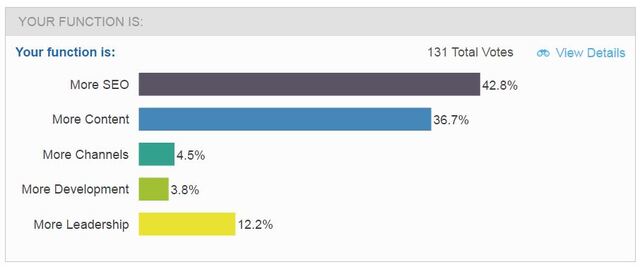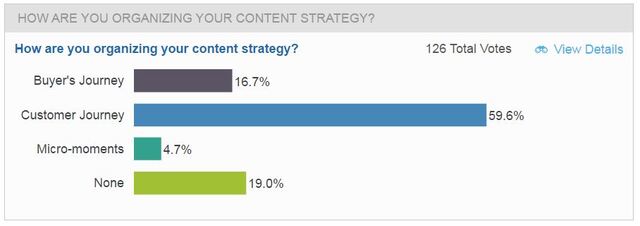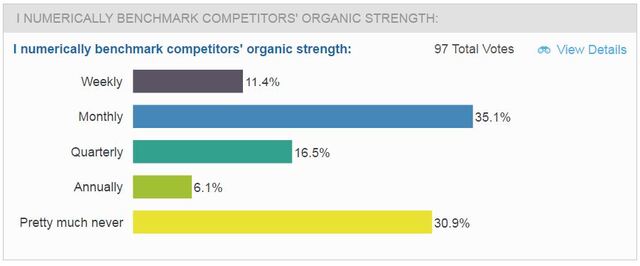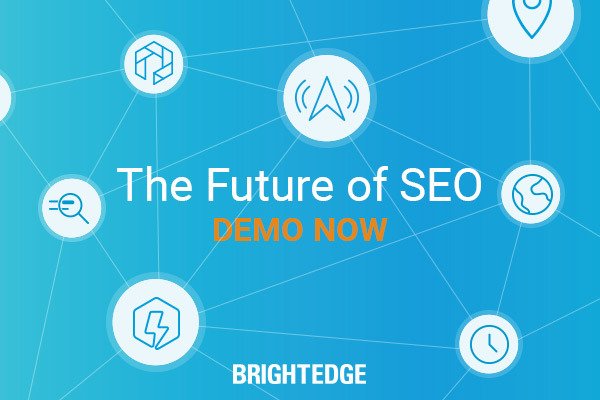By Kevin Bobowski and Erik Newton
On 1/31 BrightEdge SVP of Marketing Kevin Bobowski and VP of Demand Generation Erik Newton hosted a webinar that generated a lot of interest from the BrightEdge community. You can view an on-demand version of the webinar.
We did not have time to answer all the questions, so we will address them in this blog post. The webinar topic was using customer journey analysis and micro-moments to approach and succeed in the Universal Content area of the Google SERPs.
The webinar explained the thought process and then went into detail on 4 micro-moments: I want to know, I want to go, I want to do, and I want to buy.
We combined a use case with a sample SERP, showed the BrightEdge reporting that gives insight, and then did several quick how-tos to help achieve those positions. We followed that with a review of competitive analysis and assessment.
There were 6 live polls during the webinar, the results of one included below:
What is the best way to show revenue growth from SEO initiatives targeting Quick Answers?
The Quick Answer pages you rank for are likely to be specific and longtail style, meaning you will have a unique landing page for each topic. As you earn the Quick Answers, add them to a Page Group in BrightEdge Page Reporting to assess total traffic. Subtract the traffic to that page from before you had the Quick Answer and that will indicate the lift.
Here is the URL for the Quick Answers white paper we mentioned in the webinar.
How do I view my Quick Answers performance?
Go to BrightEdge Data Cube, type your URL, click on Content Strategies, select Quick Answers.
I see my competitors (personal injury law firms) listed in our local place listings as well as in other local searches in google, but they don't have a local office here at all. Why do they rank in so many local searches and page-one results of organic as well?
It is possible they are paying for the position in Local - look for the ad mark. It is also possible they have a shell office in your area and have done the footwork to register that location with Google My Business. As to why they rank well in general, I would have to guess that they are doing a decent job of content marketing, SEO, and generating backlinks.
What are the B2B stats regarding micro-moments? and Do you find the Local 3-Pack or the "I Want to Buy" or the Google Places queries are relevant for nationwide B2B firms?
This blog from Greg Sterling lists the data and the sources. While B2B data for Local and Places may be less relevant in B2B, the Quick Answers opportunity is highly relevant as customer journey analysis shows B2B buyers are doing extensive research online before even contacting providers.
Secondly, B2B buyers often use desktop for their queries, but peer-based reviews and recommendations or even social-targeted ads or account based marketing could cause them to make mobile queries. Younger generations are more mobile and sometimes entirely mobile, so micro-moments are an opportunity in all segments.
Do you have an example of good B2B content marketing?
Yes, there are many within the BrightEdge community. The asset types are: site, blog, white paper, research paper, e-book, case study, infographic, images, and audio. Take a look at the BrightEdge Resources Center for ideas.
How would a national or regional service provider compete with local providers?
If the national provider has local locations, the customer journey analysis says that you would optimize the location pages of the site aggressively. If it is an online national then I suggest content marketing to rank well generally and go for How-to as we showed in the Home Depot example in the presentation.
What if you're national with many local locations?
You will need to track and optimize each location separately to get those local store pages to rank.
What's a best practice for using real search queries for web or blog content?
Targeting demand is the best first step for content generation. Target high demand queries to "fish where the fish are". It increases your chance of generating traffic that impacts your business. This process is why more than 22,000 users love BrightEdge and the Data Cube.
Our web site is horrible. We sell nearly 100mm via Home Depot.com, Amazon, wayfair, etc. How can SEO up rankings inside those portals?
Well, congratulations on doing such great volume through your channel partners. Channel strategy and execution are always tricky. We are planning to cover shopping platform optimization in a future webinar, so watch for the webinar invites.
What kind of recommendations do you give for the existing content that is ranking - if you've done meta data/headline changes as well on-page?
If your meta data, H1 and H2 are tuned, then work on content depth and density. We are guiding to 1500 words and 2-4% keyword topic density. Then consider schema data. If that is on target then it is backlinks.
On the Share Insights Roadshow, we had audience members advocate for their cities.
The 4 cities we have announced are New York 5/8, Chicago 6/8, San Francisco 6/21, and London 10/5. We plan to add many more events across the US and internationally, so check back on the Share page.
Is there a suggested dashboard or report in BrightEdge that can display overall impact from applying some of these recommendations?
There is not a pre-formatted template, but the Data Cube is easy to view and from there you can save the reports to a dashboard. If you would like help with that, please let your CSM know. We will pass along your idea to the product management team.
I recently got access to BrightEdge. Do you have a webinar or recorded training for learning on how to use BrightEdge?
Yes, we do! Please contact your Customer Support or Onboarding Manager to view this.
What is AMP?
AMP is accelerated mobile pages, a markup defined and supported by Google to make content appear more quickly in mobile devices. Kirill Kronrod from Adobe sent all of us these links about AMP.
- https://www.ampproject.org/
- https://googleblog.blogspot.com/2015/10/introducing-accelerated-mobile-pages.html
- https://searchenginewatch.com/sew/opinion/2430844/google-s-amp-project-what-will-be-the-impact-on-publishers
I would like to do a blog with BrightEdge on an AMP case study.
Great, customers are always welcome to propose and deploy blogs and case studies with us.
Is AMP just for news pages and local pages for now? Or do you see other possibilities?
Google is advocating for AMP strongly and has indicated it will become a factor in other types of content ranking. We believe the community should keep an eye on it by tracking AMP Preferred pages in BrightEdge and consider using BrightEdge Content to find and create content because it automatically creates AMP-enabled pages for our customers.
Thanks for the comprehensive presentation! Do you still consider Striking Distance terms, terms in positions 3-20?
Thanks for joining us. Yes, we think that is a good range because positions 3, 2, and 1 get disproportionate exposure and traffic, especially in mobile. Given the mobile-first push, we are recommending customers to track mobile and desktop separately as we are seeing different results on 73% of queries already and rising each month.
The care micro-moment is for the moment that a customer has the product and is using it. I think this is a really important.
Good point. At BrightEdge we see marketing as a vertical function across the whole customer lifecycle, and SEO plays a role all the way along. We focused on know, go, do, and buy in this webinar and could expand the micro-moments in a future webinar.
What else did Kevin buy at The Home Depot besides the dimmer switches?
I picked up light bulbs, grass seeds, and fertilizer with my 3 dimmer switches. Nice add-on sale from their successful I-want-do micro-moment how-to video.






